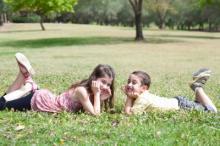
Playing outdoors is one of the things that characterize childhood, giving children the opportunity to explore, discover, practice, wonder, change, create, and learn about the world around them. Children’s basic needs for freedom, adventure, risk-taking, experimentation, and just being children are enhanced by outdoor environments.1 Children can express themselves with more active movement, louder voices, messier activities, and more rough and tumble play in outdoor settings.2
There are two common misconceptions about outdoor play: 1) that outdoor play is just a time for children to expend excess energy, and 2) that playgrounds are just places for children to develop gross motor skills. There is overwhelming evidence that suggests that the benefits of outdoor play are extensive. Playgrounds are among the most important environments for children outside their own homes. Newly-designed playgrounds have specific objectives for children’s development. This new playground equipment provides opportunities for children to make decisions, try ideas, and stretch their physical abilities.3
Outdoor free play is the spontaneous play that comes naturally from children’s natural curiosity, love of discovery, and enthusiasm.4 Children learn best when all of their senses are involved and they are engaged in self-initiated, hands-on exploration of the world around them. Interacting with the natural world gives them an appreciation for the natural order of things in the environment and a respect for nature.5
When children play outdoors, they stay far more active than when indoors. This allows them to exercise their large muscle groups while engaging in activities, such as running, climbing, swinging, jumping, and riding bicycles. Cardiovascular endurance, large motor skills, and fine motor skills are developed with active outdoor play. Children are more fit, have better bone health, better body composition, and can maintain a healthier weight if they participate in vigorous activity.6 General health is enhanced with the exposure to fresh air and the outdoors, which are believed to reduce respiratory infections, inhibit the spread of germs, and promote healthy immune systems.7
The development of social skills is promoted by outdoor activities. Children learn to be cooperative while waiting their turn to go down the slide, working with others to build a sand castle, or playing an organized game. Developing interpersonal relationships and learning conflict resolution skills are valuable lessons acquired.8
Children play differently outdoors than they do indoors with children engaging in more solitary activity indoors.9 The outdoor environment offers greater availability of low-structured, non-realistic, natural materials, and spaciousness that encourages pretend play. Boys engage in more dramatic play and girls are more assertive when playing outdoors.10
In a study done in 2004, 71% of mothers reported that they played outdoors more than indoors when they were young, while only 26% said their own kids do that today.11 There are many factors that have diminished the amount of outdoor play children have today. Excessive TV, computer use, and video games keep children indoors. Unsafe neighborhoods and busy, overworked parents diminish opportunities for outdoor play. Academic standards raised by the No Child Left Behind Act and the reduction of recess and physical education take time away from outdoor activity.12
- 1. “Outdoor Play.” Community Playthings. < http://www.communityplaythings.com/resources/articles/outdoorplay/outdoorplay.html > 01 Sept. 2010.
- 2. Frost, Joe L., Sue Wortham, and Stuart Reifel. Play and Child Development. Upper Saddle Valley, NJ: Prentice-Hall, 2001. p. 430.
- 3. Frost, Joe L., Pei-San Brown, John A. Sutterby, Candra D. Thornton, The Developmental Benefits of Playgrounds Olney, MD: Association for Childhood Education International, 2004. p. 21.
- 4. “Free Play” Hasbro.com. < http://www.hasbro.com/playdoh/en_US/freePlay.cfm > 16 Aug 2010.
- 5. Rossi, Dee. “Importance of Outdoor Play for Children.” eHow. < http://www.ehow.com/about_6653745_importance-outdoor-play-children.html > 01 Sept. 2010.
- 6. Ibid.
- 7. Op. cit., Frost, Wortham, Reifel. p. 431.
- 8. Op. cit., Rossi.
- 9. “Professional Perspectives and Research on Children’s Outdoor Environments.” Natural Playgrounds Company. < http://naturalplaygrounds.com/research.php > 23 Aug. 2010.
- 10. Op. cit., Frost, Wortham, Reifel. pp. 430-431.
- 11. “Nature Play Factoids.” Green Hearts Institute for Nature in Childhood. < http://www.greenheartsinc.org/uploads/Nature_Play_Factoids_for_website_final_3.pdf > 23 Aug. 2010.
- 12. Op. cit., “Outdoor Play.”

